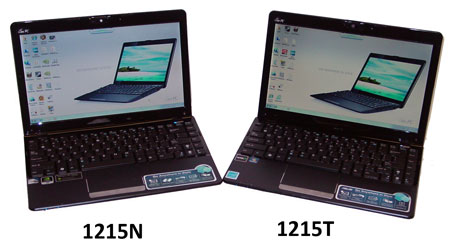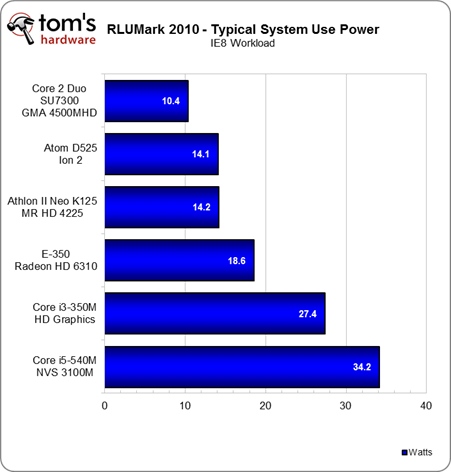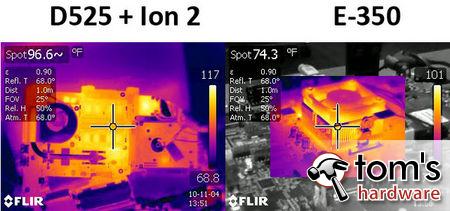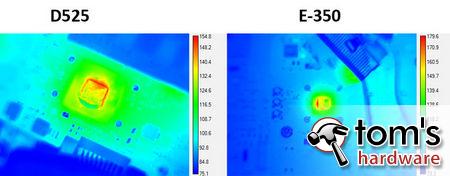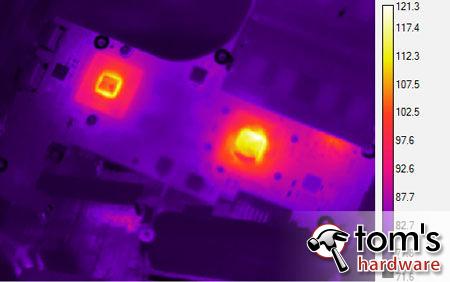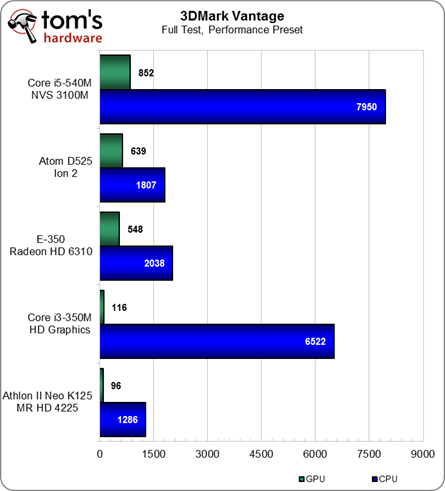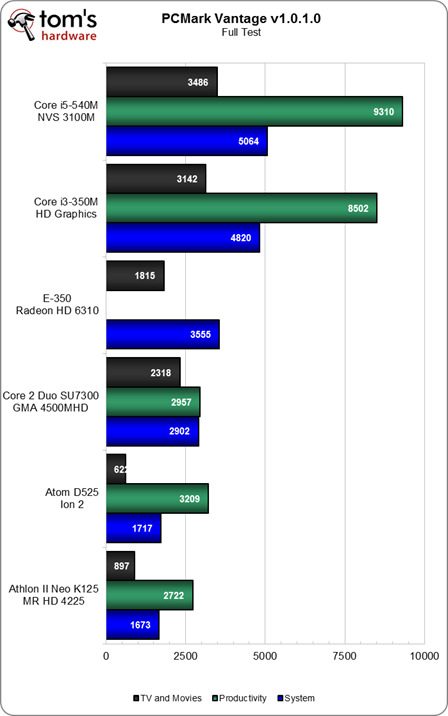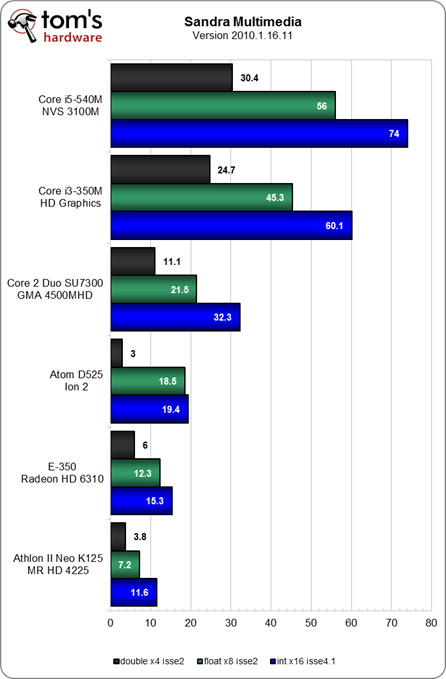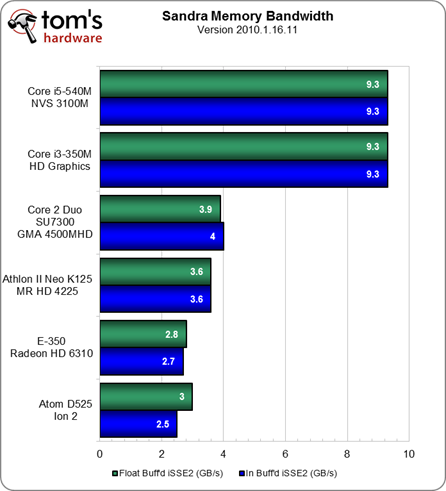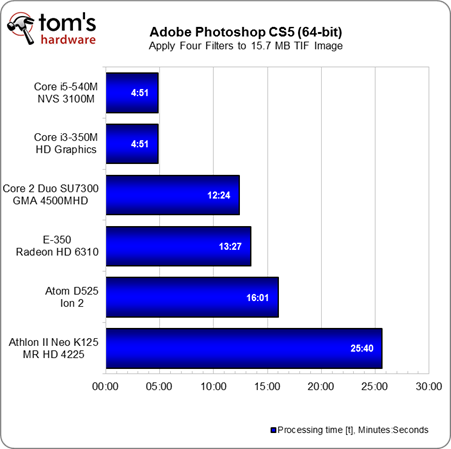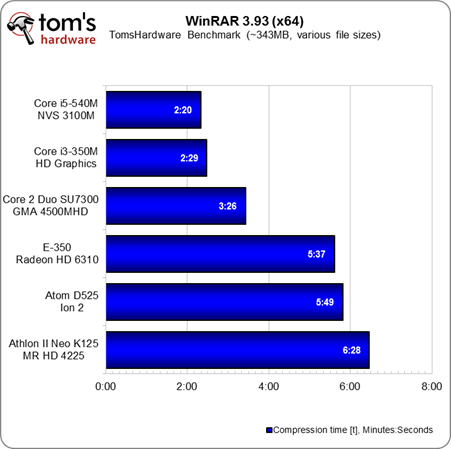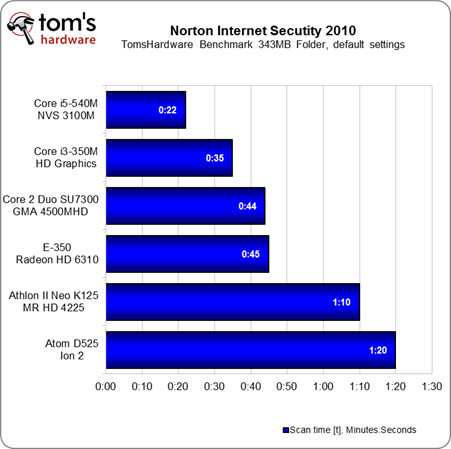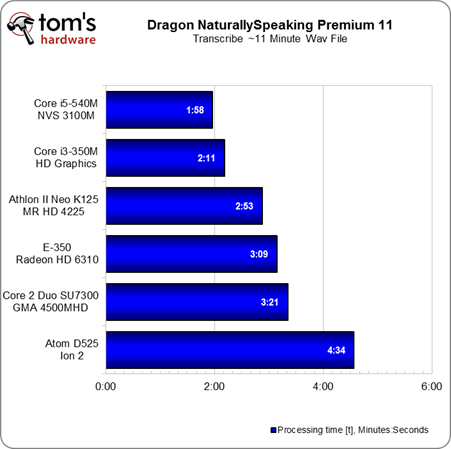
|
TopNax |
|
AMD gave us an opportunity to go hands-on with its upcoming Brazos platform--the only preview you'll see before this technology surfaces in retail notebooks. Is it fast enough to compete with the Nehalem-based competition, and cool enough to trounce Atom? One week ago, we went over the details on Brazos and Zacate. Today, we are finally allowed to go release our benchmark numbers. If you haven't read our earlier coverage, it's a good time to go back and go over all the nitty gritty details on Brazos, Zacate, and Ontario. A quick recap: Bobcat: The processing architecture behind AMD's upcoming Zacate and Ontario APUs. Brazos: AMD's 2011 platform for the ULV Zacate/Ontario APU + SB750 southbridge. It effectively replaces the high-end parts of the Nile platform. |
|
Because we were dealing with notebooks, we often have no way to control memory timings. Given that platforms often ship with memory specific to that product line, we tried not to alter memory module configurations. |
Zacate: Power And Heat |
|
AMD is trying to make a point that it has power management figured out. Comparing the E-350 APU to the company's current Nile platform (K625 + 880G), there are clearly some serious improvements being touted through the Zacate part.
As far as we're concerned, the component level is less important than total platform power. Of course, we're interested in the power consumption of a mobile platform because that helps determine the amount of time we can spend away from a wall socket.
We crunched some numbers, and based on our typical use system power numbers, the E-350 comes in at 18.6 W. This is with the system's wireless adapter active, 12.1" LED LCD set at 100 nits, and utilizing Windows' Balanced setting. How does this compare to other similar CULV notebooks? Well, thankfully, we had two examples from Asus to put things in perspective.
The 1215N (Atom D525/Ion 2) and the 1215T (Athlon II Neo K125/Mobility Radeon HD 4225) are both 12.1" LCD CULV notebooks, and they're probably the most popular in the company's eeePC line. Arguably, this form factor has also been called "the premium netbook" and we don't necessarily disagree. But this is definitely part of the CULV notebook group that AMD is vectoring towards with Zacate.
AMD's demo platform didn't have a battery connection, so we had to rig up a Electrovaya PowerPad to measure DC wattage. In our typical use scenario (IE8 Web surfing), the E-350 falls behind the previous K125 and D525/Ion2 platform. AMD tells us it is still working on closing that gap. As this is a preproduction sample, we probably can expect upwards of 10-15% power savings on top of the 18 W. Based on our use, it seems that AMD may see the biggest power savings by playing with the GPU. At the moment, it seems to be operating at max clocks all of the time.
Heat is a more intesting story, as we took the picture above while the systems were idling. It is hard to draw a definitive statement based on these pictures, because we are looking at different PCB real estate, heatsink material, heatsink size, and so on. In order to look at things more closely, we took the following pictures of the processors unshielded roughly ~45 seconds after booting.
Even though the E-350 has a higher thermal footprint per area, that is understandable, given the fact that Intel's D525 doesn't have a powerful graphics core. Moreover, you would actually need to double the thermal footprint per area of the D525 if you took Nvidia's Ion2 chipset into account.
For a CULV notebook, we don't hesitate to say that AMD has an amazing design given the lower proportional heat emissions. However, measured power consumption is still something to keep an eye on. At 18 W, the E-350 still consumes more power than what we would like to see from an AMD-based ULV processor.
In our preliminary tests, the Asus 1215N and the 1215T have similar battery life, but they get there via different approaches. The 1215N employs Nvidia's Optimus technology, which means that, at idle, its power consumption is similar to a vanilla Intel system. Meanwhile, even though the K125 is still a power hog, it has the driver support to dial back the IGP's clock rate. |
Benchmark Results: Synthetics |
|
Benchmarks: Synthetics
The numbers are pretty much what we expected, confirming AMD's earlier claims of increased performance relative to its Nile platform. For some odd reason, there was no productivity score reported in PCMark Vantage for the E-350, but we're chalking this up to a driver anomaly. We're looking at pre-production hardware here, after all.
Given the E-350's integrated memory controller, we expected similar memory bandwidth compared to the previous Nile platform. AMD is still holding back details and we need more time to test, but it seems that much of the performance benefit seen from this platform comes from lower latencies between subsystems, and not higher memory throughput. |
Benchmark Results: Productivity |
|
Benchmarks: Productivity
We’ve adapted our Photoshop benchmark to the CS5 release, though the results of our threaded filter workload don’t change much. The test takes advantage of as many cores, as possible, which is why it isn't too surprising to see the K125 fall behind the pack.
WinRAR seems to be the one application in the suite that doesn't seem to respond as favorably to the dual-core Bobcat architecture. Intel holds a distinct advantage in this test.
Symantec's Norton lineup is all but ubiquitous, so we decided to have a go at the Internet Security suite. The results mirror those seen in the WinRAR benchmark, except that the K125 and D525 are jockeying for position. Despite the fact that this suite is threaded, the K125's architecture is favored more than Atom's dual cores.
We threw in Dragon NaturallySpeaking 11 because it is a popular mainstream application. The Transcribe From Audio Recording function is partially multi-threaded but it is also sensitive to clock rate, which is why we see the K125 ahead of the ULV processors. Overall, the E-350 is pretty competitive with the Core 2 Duo SU7300, which is where AMD is pegging the competition. |
AMD Fusion: Brazos Gets Previewed: Part 2, Performance |
|
Test Hardware |
|||||||
|
Processors |
Intel Atom D525 (Dual-Core, 1.8 GHz) |
Intel Core 2 Duo SU7300 (Dual-Core, 1.3 GHz) |
Simulated Intel Core i3-330UM (Dual-Core, 1.2 GHz) |
Intel Core i3-350M (Dual-Core, 2.26 GHz) |
Intel Core i3-540M (Dual-Core, 2.53 GHz) |
AMD Athlon II Neo K125 (Single-Core, 1.7 GHz) |
AMD E-350 (Dual-Core, 1.6 GHz) |
|
Memory |
4 GB DDR3-1066 |
4 GB DDR2-800 |
4 GB DDR3-1066 |
4 GB DDR3-1066 |
4 GB DDR3-1333 |
4 GB DDR3-1333 |
4 GB DDR3-1333 |
|
Graphics |
Nvidia Ion2 |
Intel GMA 4500MHD |
AMD Radeon HD 5450, 1 GB DDR2 |
Intel HD Graphics |
Nvidia Quadro NVS 3100M |
AMD Radeon HD 4225 |
AMD Radeon HD 6310 |
|
Notebook |
Asus eeePC 1215N |
Asus UL20A |
Desktop System |
Dell Vostro 3300 |
Lenovo Thinkpad T510 |
Asus eeePC 1215T |
- |
|
Operating System |
Windows 7 Ultimate 64-bit |
||||||
|
DirectX |
Direct X11 |
||||||
|
Graphics Driver |
260.99 (Nvidia) |
8. 14.10.2117 |
8.782 |
8. 14.10.2226 |
260.99 |
8.782 |
8.789 |
|
Benchmarks and Settings |
|
|
Video Encoding |
|
|
Cyberlink MediaExpresso 6 |
Version: 6.0.1026.32053, Convert 1080p 16 Mb/s H.264 video file to MPEG-2 352x288 6 Mb/s |
|
Applications |
|
|
WinRAR 3.93 |
Version 3.93 (64-bit), Benchmark: THG-Workload (334 MB) |
|
Dragon NaturallySpeaking |
Version 11.00.200.049, Transcribe Audio 14.1 MB Wav Recording (Duration: 11:12) |
|
Adobe Photoshop CS5 (64-bit) |
Radial Blur, Shape Blur, Median, Polar Coordinates filters |
|
Norton Antivirus |
Version: 18.1.0.37, Benchmark: Scan 334 MB Folder of ZIP/RAR compressed files |
|
Synthetic Benchmarks and Settings |
|
|
3DMark Vantage |
Version: 1.02, GPU and CPU scores |
|
PCMark Vantage |
Version: 1.00, System, Memories, TV and Movies, and Productivity benchmarks, Windows Media Player 10.00.00.3646 |
|
SiSoftware Sandra 2010 |
CPU Test=CPU Arithmetic/Multimedia, Memory Test=Bandwidth Benchmark |
|
Games |
|
|
World of Warcraft: Wrath of the Lich King |
Fair Quality Setting, No AA / 2xAF, 4xAA / 16xAF, vsync off, 1280x720, 4 minute sequence, Fraps |
|
Aliens vs. Predator Benchmark |
Ultra High Settings, 4xAA / 16xAF, 1366x768, Built-In Benchmark |
|
DiRT 2 |
Modified Medium Setting, 2xAA 1366x768, In-Game Benchmark, Steam Version |

